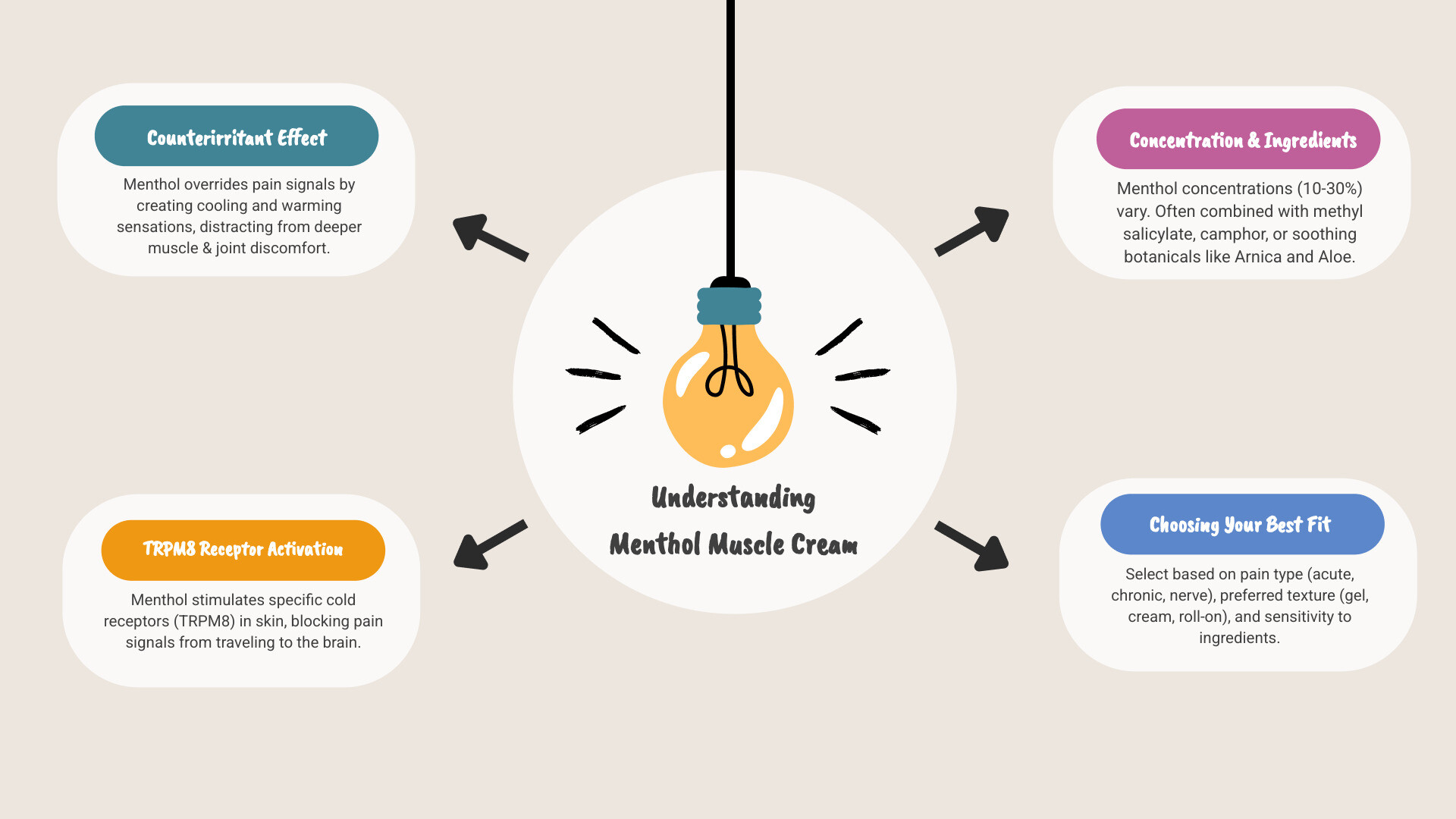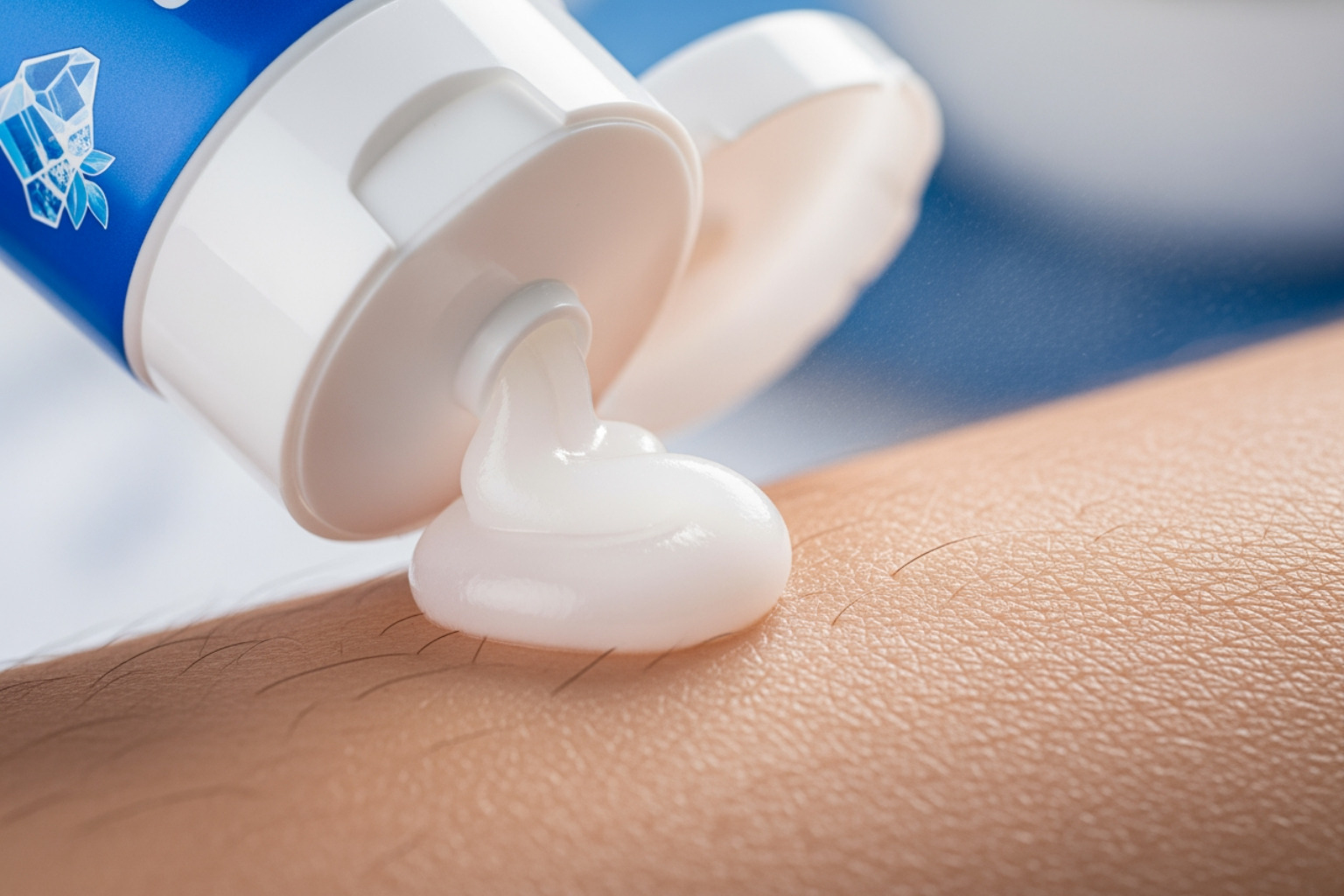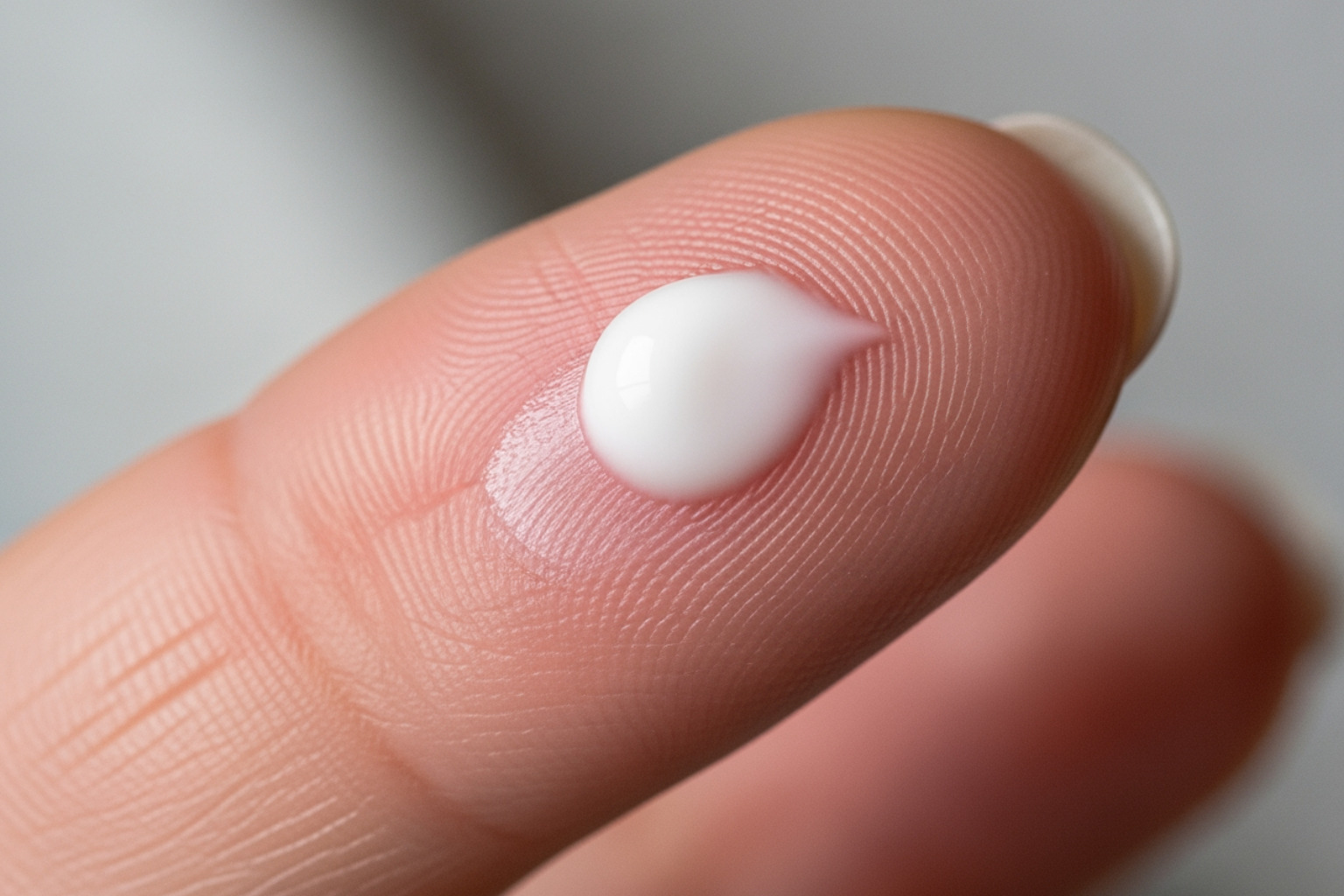Why Choosing the Right Menthol Muscle Cream Matters
Menthol muscle cream offers fast, targeted relief for muscle aches, joint pain, and nerve discomfort. It works by creating cooling and warming sensations that override pain signals traveling to your brain. With so many menthol-based products available, understanding the key differences helps you select the most effective option for your needs.
Quick Comparison Guide:
| Product Type | Best For | Key Features |
|---|---|---|
| High-Strength Formulas | Acute strains, intense pain | 10-16% menthol, strong sensation |
| Cooling Gels & Roll-Ons | Post-workout recovery | Fast-acting, mess-free application |
| Multi-Ingredient Botanicals | Chronic pain, nerve discomfort | Added Aloe, MSM, Arnica for soothing |
Menthol stimulates your skin's cold receptors (TRPM8), which blocks pain signals from reaching the brain. This counterirritant effect provides a cooling sensation that distracts from deeper pain. Over-the-counter products contain 1-16% menthol [1], often combined with other ingredients like camphor or botanicals for improved relief.
The right choice depends on your pain type and sensitivity. Athletes may prefer fast-absorbing gels, while those with chronic nerve pain can benefit from formulas with hydrating ingredients like aloe vera.
I'm Tony Enrico, and I've spent years developing menthol muscle cream formulations that deliver real relief. Through Neuropasil, I've helped thousands find effective solutions for muscle, joint, and nerve pain using science-backed blends of menthol and soothing botanicals.

Menthol muscle cream word roundup:
Understanding How Menthol Muscle Cream Provides Pain Relief
When you apply menthol muscle cream, you feel a cooling sensation that eases discomfort. But how does it work? Pain is a signal sent from an affected area, up the spine, and to the brain. Menthol cleverly intercepts this signal before your brain fully processes it.
The secret is menthol's role as a counterirritant. It activates specific cold receptors in your skin (TRPM8), creating a powerful cooling sensation that crowds out the pain signals. Your brain focuses on the cooling instead of the deeper ache, a mechanism detailed in the science of menthol's pain-relieving properties [7]. This provides fast, targeted relief right where you apply it, unlike oral medications that affect the entire body. You can learn more about why menthol helps with pain relief and how this localized approach works.
Common Active Ingredients in Muscle Creams
While menthol is the star, it often works with other ingredients for comprehensive relief.
- Menthol: Typically found in 1% to 16% concentrations [1], it's derived from mint oils and creates the primary cooling, pain-distracting effect.
- Methyl Salicylate: A topical NSAID with a distinct wintergreen scent, it creates a warming sensation that complements menthol's cooling. Use with caution if you have an aspirin allergy [2].
- Camphor: Another counterirritant that produces both cooling and warming sensations for a strong, penetrating feeling of relief [1].
- Capsaicin: Derived from chili peppers, it creates a warming sensation that depletes a pain-transmitting neurotransmitter [3]. It works through heat rather than cooling.
- Lidocaine: A local anesthetic that numbs the area by blocking nerve signals, sometimes combined with menthol for intense pain.
Beneficial Supporting Ingredients
The best menthol muscle cream products also include ingredients that nourish skin and improve the formula's effectiveness.
- Arnica: A botanical extract used for centuries to reduce bruising, swelling, and soreness [4].
- MSM (Methylsulfonylmethane): A sulfur compound believed to help with joint pain and inflammation [5].
- Aloe Vera: Soothes irritated skin, promotes healing, and helps other ingredients absorb more effectively. It's a key component in our Neuropasil formula.
- Urea: A humectant that hydrates skin and acts as a penetration improver, helping active ingredients reach deeper into tissues for faster, more effective relief. This is another cornerstone of our Neuropasil formula.
- Boswellia: Also known as Indian frankincense, it has potent anti-inflammatory effects that help reduce swelling and pain [6].
The magic happens when these ingredients work in synergy. Our Neuropasil creams combine menthol with aloe, urea, and other botanicals to create a synergistic blend that transforms muscle and nerve recovery. The menthol provides immediate cooling, urea improves penetration, and aloe soothes the skin. You can read more about how aloe and menthol formulas like Neuropasil deliver fast, soothing relief.
How to Choose the Best Menthol Cream for Your Needs
With so many options, selecting the ideal menthol muscle cream can feel overwhelming. The best choice depends on your unique pain, skin sensitivity, and daily routine.

When choosing, consider these factors:
- Menthol Concentration: Higher percentages (up to 16%) offer a more intense cooling sensation but also a higher risk of skin irritation. Start lower if you have sensitive skin.
- Additional Ingredients: Look for warming agents like methyl salicylate, numbing agents like lidocaine, or soothing botanicals like arnica and aloe vera, depending on your needs.
- Pain Type: Simple muscle soreness responds well to basic formulas. Joint or nerve pain may benefit from creams with anti-inflammatory and soothing ingredients like MSM, aloe, and urea.
- Formula Texture: Athletes and active individuals often prefer a non-greasy muscle and joint pain cream with menthol, urea & aloe for fast, non-sticky relief.
- Application Method: Creams allow for massage, while roll-ons offer mess-free convenience.
High-Strength Formulations (e.g., Bengay, Icy Hot)
Products like Bengay and Icy Hot deliver powerful, fast relief with high concentrations of active ingredients like menthol (10-16%), methyl salicylate, and camphor (specific concentrations can be verified on product labels or a database like DailyMed [8]). Their signature "icy-hot" sensation is effective for deep aches and acute muscle strains. However, this strength comes with a strong medicinal scent and a higher potential for skin irritation, so they may not be suitable for everyone, especially those with sensitive skin.
Cooling Gels & Roll-Ons (e.g., Biofreeze)
Brands like Biofreeze offer a purely cooling approach with fast-acting gels and roll-ons. These are perfect for post-workout recovery and on-the-go relief due to their no-mess application. Athletes and physical therapists favor them for their convenience and immediate cooling effect. The main trade-off is that these formulas are typically less moisturizing than traditional creams, as they are designed for quick absorption.
Multi-Ingredient Menthol Muscle Cream with Botanicals (e.g., Penetrex, Neuropasil)
This category takes a holistic approach, combining menthol with botanicals and other compounds to address pain from multiple angles. These creams are excellent for chronic pain, joint discomfort, and nerve pain because they aim to reduce inflammation and support skin health, not just mask pain.
Penetrex combines menthol with arnica, MSM, and Boswellia to soothe discomfort. At Neuropasil, we pair menthol with soothing aloe vera and the penetration-improver urea. This combination is specifically engineered for nerve-related issues like neuropathy and sciatica, where skin is often sensitive. The aloe and menthol formula delivers fast, soothing relief for nerve and muscle discomfort by working with your skin, not against it.
This versatile approach is also effective for muscle soreness, strains, and general aches. You get the benefit of ingredients that support healing and comfort, all in a non-greasy cream suitable for daily use.
Proper Application and Safety Guidelines
To get the most from your menthol muscle cream safely, proper application is key. A few simple guidelines can make all the difference between effective relief and an unpleasant experience.

With concentrated formulas, more isn't better. A pea-sized amount is often all you need for a targeted area. Always follow the directions on the product label for safe, effective relief. For a complete overview, see the complete guide to a menthol-based relief formula: ingredients, safety, and daily use tips.
How to Apply Menthol Muscle Cream for Optimal Results
- Start with clean, dry skin. This ensures better absorption and prevents irritation.
- Apply a thin, pea-sized layer. A small amount goes a long way.
- Massage gently into the affected area until fully absorbed to stimulate blood flow.
- Follow the recommended frequency, typically no more than 3-4 times daily.
- Wash your hands thoroughly after application to avoid accidentally spreading the cream to sensitive areas like your eyes.
Potential Side Effects and Important Warnings
While generally safe, it's important to use menthol muscle cream correctly and be aware of potential issues.
- Skin Irritation: Mild redness, warmth, or tingling is normal. However, if irritation is severe, spreads, or persists, stop use.
- Allergic Reactions: Though rare, signs include a rash, hives, severe dizziness, or difficulty breathing. If these occur, stop use and seek immediate medical attention.
- When to Stop Use: Discontinue and consult a doctor if your condition worsens, symptoms last more than 7 days, or symptoms clear up and return within a few days.
- Avoid Sensitive Areas: Never apply to broken or irritated skin, open wounds, or mucous membranes (eyes, nose, mouth).
- Do Not Use with Heat: Applying a heating pad or tight bandage over the cream can cause severe skin irritation or burns. Avoid hot baths or intense exercise immediately before or after application.
- Pregnancy and Breastfeeding: Consult your healthcare provider before use, especially with products containing methyl salicylate.
- Children: Always consult a doctor before using on children under 12. Products with methyl salicylate should not be used on children due to risk of serious side effects [2].
- Drug Interactions: Inform your doctor or pharmacist about all products you use, including topical creams. For more details, WebMD provides comprehensive safety information.
Using menthol muscle cream correctly is the best way to ensure safe and effective pain management.
Frequently Asked Questions about Menthol Creams
Many customers have the same questions when exploring their pain relief options. Let's tackle some of the most common ones about what menthol muscle cream can and can't do.
Can I use menthol cream for nerve pain like sciatica or neuropathy?
Yes, menthol muscle cream can be very effective for nerve-related discomfort like sciatica or neuropathy. While menthol works by creating a cooling distraction that blocks pain signals, the most beneficial formulas include supporting ingredients. Creams with aloe vera and urea are especially helpful, as aloe soothes hypersensitive skin and urea improves penetration, helping the active ingredients reach deeper. At Neuropasil, our formulas are specifically designed with this in mind, providing targeted relief while nourishing delicate, nerve-affected skin. Learn more about how aloe and menthol formulas like Neuropasil deliver fast, soothing relief for nerve and muscle discomfort.
How long does the relief from menthol cream last?
The relief from menthol muscle cream is temporary, with effects from topical analgesics typically lasting for several hours, depending on the formula, your body chemistry, and your pain level [3]. These creams are designed for as-needed use to manage symptoms throughout the day. Most products recommend reapplying no more than 3 to 4 times daily to maintain comfort.
Is a higher percentage of menthol always better?
Not necessarily. While a higher concentration of menthol (10-16%) provides a stronger cooling sensation, it doesn't automatically mean better pain relief for everyone. In fact, high concentrations can increase the risk of skin irritation, redness, or a burning feeling, especially on sensitive skin. A balanced formula is often more effective. When menthol is combined with other beneficial ingredients like aloe vera, urea, or arnica, it creates a more comprehensive solution that addresses inflammation and skin health, leading to more comfortable and complete relief without an overwhelming icy blast.
Conclusion: Finding Your Perfect Match for Pain Relief
Navigating topical pain relief is easier when you understand the nuances of menthol muscle cream. We've covered how menthol interrupts pain signals and how different ingredients and formulations can be custom to your specific needs.

From high-strength formulas for acute pain to cooling gels for post-workout recovery and holistic, botanical blends like Neuropasil for chronic or nerve-related discomfort, there is a solution for you.
The key is to consider your pain type, preferred ingredients, and lifestyle. Always apply the product correctly and follow safety warnings to ensure the best results.
With this knowledge, you can confidently choose a menthol muscle cream that helps you manage pain and get back to living life to the fullest. To continue your journey, we invite you to discover the ultimate guide to muscle relief creams.
References
- U.S. Food and Drug Administration. "CFR - Code of Federal Regulations Title 21, Part 348: External Analgesic Drug Products for Over-the-Counter Human Use." https://www.accessdata.fda.gov/scripts/cdrh/cfdocs/cfcfr/CFRSearch.cfm?fr=348.10
- WebMD. "Muscle Rub With Methyl Salicylate-Menthol Topical: Side Effects, Uses, Interactions." https://www.webmd.com/drugs/2/drug-165913/muscle-rub-ultra-strength-with-menthol-topical/details
- Derry, S., et al. "Topical analgesics for acute and chronic pain in adults - an overview of Cochrane Reviews." Cochrane Database of Systematic Reviews, 2017. https://www.cochranelibrary.com/cdsr/doi/10.1002/14651858.CD008609.pub2/full
- National Center for Complementary and Integrative Health. "Arnica." https://www.nccih.nih.gov/health/arnica
- National Center for Complementary and Integrative Health. "MSM (Methylsulfonylmethane)." https://www.nccih.nih.gov/health/msm-methylsulfonylmethane
- National Center for Complementary and Integrative Health. "Boswellia." https://www.nccih.nih.gov/health/boswellia
- WebMD. "Muscle Relief Topical (Menthol Topical): Side Effects, Uses, Interactions." https://www.webmd.com/drugs/2/drug-22058-2101/muscle-relief-topical/menthol-topical/details
- DailyMed. "Label Information from the National Library of Medicine." https://dailymed.nlm.nih.gov/dailymed/













